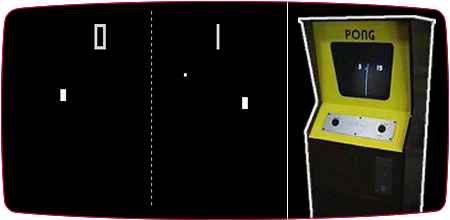Pong (series)

Retro Coin Op Synopsis
“Insert Coin. Avoid Missing Ball for High Score.”
Those eight little words of instruction were all anyone needed to know to enjoy a rousing game of Pong. Atari founder Nolan Bushnell had learned a sad lesson from his experience with Computer Space, his (and the world’s) first coin-op video game. Games needed to walk before they could run, and simplicity was the first step.
With the meager proceeds from Computer Space, Bushnell founded a company he called Syzygy. Strangely enough, the name was already taken, so Bushnell settled on “Atari,” the equivalent of “check” in the Japanese game of Go. The company’s first project was a riff on a game Bushnell had seen demonstrated on the original Odyssey 100 home system, a sort of video table tennis. Bushnell asked associate Al Alcorn to develop Atari’s own version, a game eventually known as Pong.
As the instructions indicated, Pong was incredibly easy to understand. Two players controlled small white bars on opposite sides of a black screen. A ball bounced between the two, and players had to maneuver their paddles up and down to intercept the ball and volley it back to the other side. If you missed, the other guy got a point. It was that simple.
Still unsure of the game’s potential, Bushnell and Alcorn decided to test out a prototype in a Southern California bar named Andy Capp’s. That evening, Alcorn got a call from the bartender. The game had quit working. Alcorn rushed over, examined the machine, and found out that the makeshift coin box had overflowed with quarters, disrupting the inner mechanics. Atari had a hit on its hands.
Bushnell and Alcorn decided to manufacture Pong themselves, setting up a jerry-rigged factory and cranking out machines in attractive yellow and blue cabinets. Pong swept the nation, and video games suddenly became big business. Companies manufactured dozens of Pong clones and Pong variations, including several from Atari itself. Pong Doubles allowed four players at once, with two on each side. Quadrapong gave all four players sides of their own—left, right, top and bottom. Once a player let four balls through his goal, that side closed and others played on.
Through the rest of the decade, Atari found new ways to keep the game fresh, even twisting the concept into the hit Breakout series. In the meantime, Atari and other companies built on the foundation that Pong had laid, creating the first arcade generation and forming what has now become a multi-billion-dollar industry.
Arcade Machine Release History
1972 - Pong1972 - Pong Doubles
1974 - Quadrapong
Arcade Game Sub Categories
sportsother
